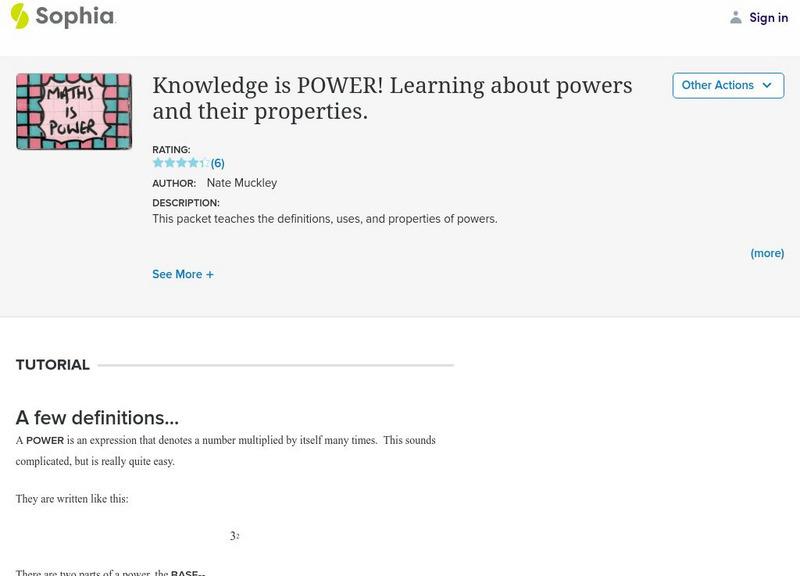Hi, what do you want to do?
Curated OER
Lesson Plan for Fontana Mines
Students estimate and compute with rational numbers. They compare, order and convert among fractions, decimals and percents. Students analyze problems to determine if there is sufficient or extraneous data to solve.
Curated OER
Geometry /Tessellations
Students investigate the concept of tessellations and how they are formed using angles. They categorize how different patterns do and not tessellate and separate them into two different places for assessment. The teacher draws examples...
Curated OER
The Measurement of All Things: Atmospheric Detectives
Learners identify the characteristics of aerosols. Using remote sensing, they participate in an experiment in which they determine how the sun's radiation and elements in the atmosphere interact with one another. They also research the...
Curated OER
African Americans in Science
Students examine the life of renowned African American scientists. In this science literacy lesson, students explore a website containing profiles and achievements of past and present African American scientists. They prepare a poster...
Curated OER
GDP and Standard of Living
Seventh graders discuss the GDP and Middle Eastern nations. In this standard of living lesson, 7th graders complete a worksheet during a lecture on the GDP. Students identify the impact of the GDP on a country and reasons for wanting to...
Illustrative Mathematics
Illustrative Mathematics: Salad Dressing
The purpose of this task is to have students add fractions with unlike denominators and divide a unit fraction by a whole number. This accessible real-life context provides students with an opportunity to apply their understanding of...
Illustrative Mathematics
Illustrative Mathematics: 7.rp Sore Throats, Variation 1
A performance task asking students to choose and apply an appropriate equation to determine an equivalent ratio for two salt and water mixtures.
Illustrative Mathematics
Illustrative Mathematics: 8.g.b.7: Spiderbox
The purpose of this task is for students to work on their visualization skills and to apply the Pythagorean Theorem. Aligns with 8.G.B.7.
John F. Kennedy Center
The Kennedy Center: Balancing Mobiles
For this lesson plan, students will apply mathematical, science, and engineering concepts to experiment with balancing levers. They will learn to classify types of levers to design and build a simplified mobile. Students will explore...
Illustrative Mathematics
Illustrative Mathematics: 6.ee Equivalent Expressions
In this problem, we have to transform expressions using the distributive, commutative and associative properties to decide which expressions are equivalent. Common mistakes are addressed, such as not distributing the 2 correctly. Aligns...
PBS
Pbs Learning Media: How Many Jelly Beans?
In this video segment from Cyberchase, Inez estimates whether she has enough jelly beans in her large container to decorate all of the cookies in her batch.
Shodor Education Foundation
Shodor Interactivate: From Probability to Combinatorics and Number Theory
Apply division to determine the probability of outcomes with a racing game.
Microsoft
Microsoft Education Lesson Plan: Making Money From Lemons
Simulation where learners apply mathematics and economics concepts in the lemonade business. Learners set up a virtual lemonade stand and must determine production costs, product variables, and profits. Young scholars record data...
Sophia Learning
Sophia: Inverse Operations
Inverse operations are investigated in this mathematics resource. Students watch a video tutorial with examples on how to apply inverse operations.
Annenberg Foundation
Annenberg Learner: Reasoning About Fractions
Apply the reasoning and proof standard to a problem based on the Fraction Tracks game. Students practice building fractions by combining fraction pieces.
Oswego City School District
Regents Exam Prep Center: Negation: Not
Use this website to help you hone your critical thinking and math-problem solving skills. Learn what "Negation," is and how it applies when you are working on mathematical problems and sentences.
TeachEngineering
Teach Engineering: Patterns and Fingerprints
Students apply several methods developed to identify and interpret patterns to the identification of fingerprints. They look at their classmates' fingerprints, snowflakes, and "spectral fingerprints" of elements. They learn to identify...
Sophia Learning
Sophia: Powers and Their Properties
The learning resource investigates the laws of exponents. Students learn how to apply the power of a power, product of a power, and power of a product rules.
University of Cambridge
University of Cambridge: Maths and Sports: Olympic Records
Can you work out which Olympics athletics event each anonymised graph of Olympic records data represents? This activity, aimed at Key Stage 3 (age 11-14), gives students the opportunity to make sense of graphical data and challenges them...
Alabama Learning Exchange
Alex: Quilting With My Pal, Pythagoras!
In this unit instructional activity, middle schoolers will learn about the Pythagorean Theorem and how it is evident in our everyday world. Students will apply the concept of the Pythagorean Theorem to the squares of a quilt. Each quilt...
Alabama Learning Exchange
Alex: Growing in a Triangle
Middle school students explore the Pythagorean Theorem by measuring and calculating diagonal lengths using the Pythagorean Theorem. Students view an animated proof of the Pythagorean Theorem. They access an Internet site to view and...
Alabama Learning Exchange
Alex: Using Scale Factors: Drawing Your Body to Scale
Teachers will use this lesson to review and apply skills involving scale factors. Teachers will use illuminations website to review scale factor. Then students will be given instructions to draw their bodies to scale.
Alabama Learning Exchange
Alex: Maybe Maybe Not
In Maybe, Maybe Not middle schoolers will explore and investigate components of probability. This lesson plan will enable students to develop understanding of a likelihood line and apply events to the line. This lesson plan was created...
Alabama Learning Exchange
Alex: Similar Figure Activity
The purpose of this lesson is to allow middle schoolers to self-discover the relationships between similar figures. The students should then take what they learn about these relationships and apply these concepts to problem-solving.
























